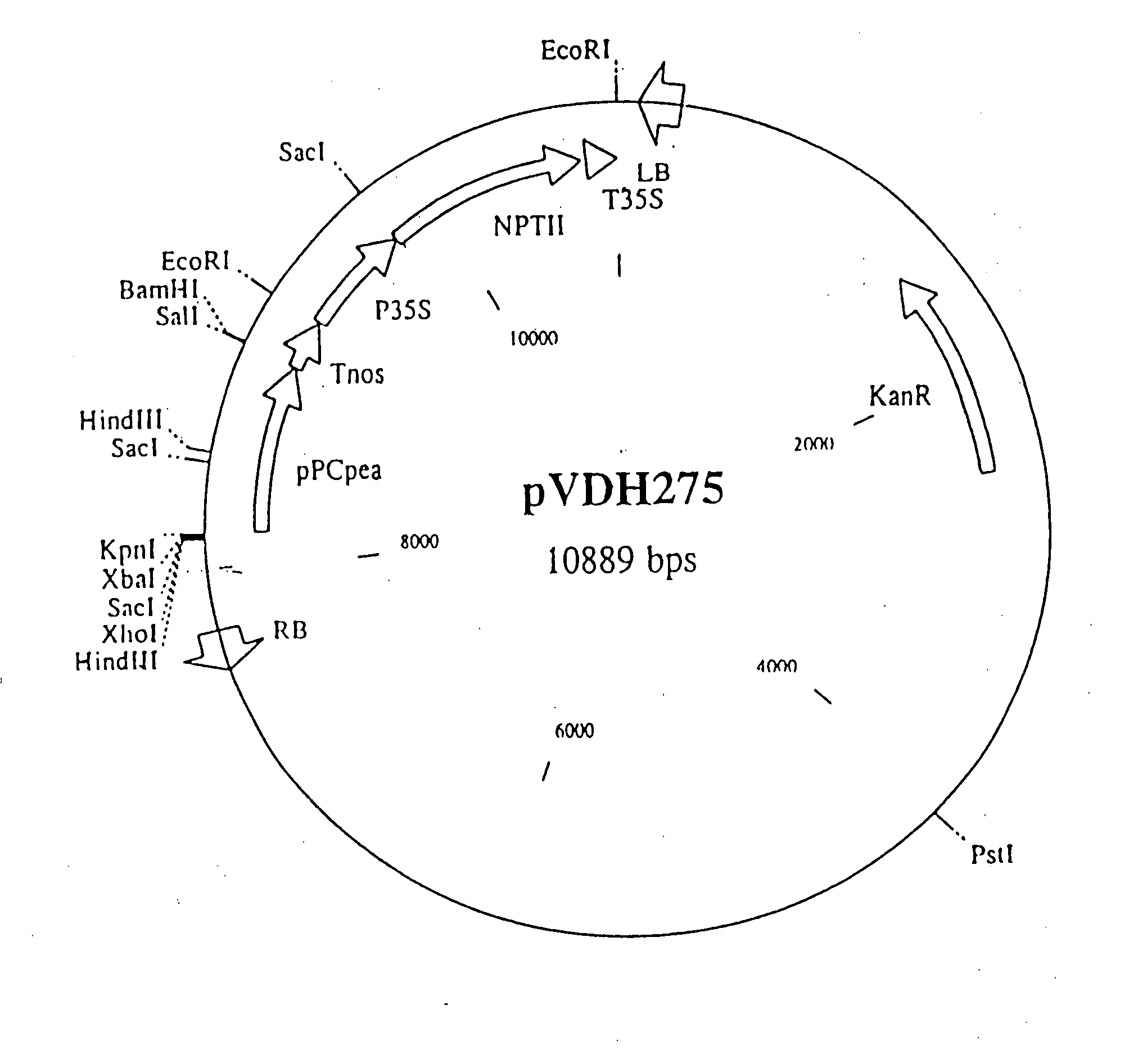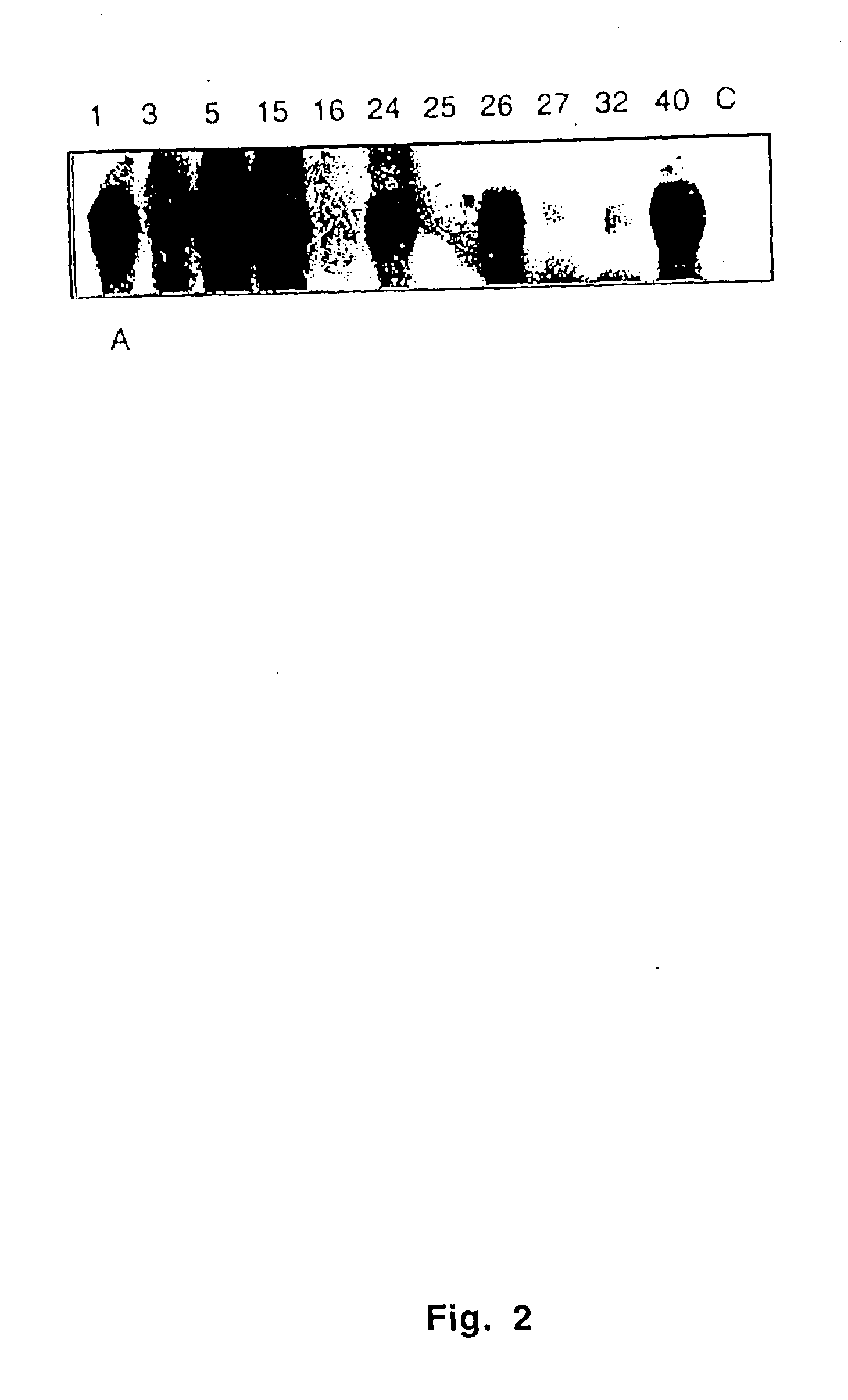Regulating metabolism by modifying the level of trehalose-6-phosphate
a technology of trehalose-6-phosphate and metabolism, applied in the direction of enzymology, organic chemistry, transferases, etc., can solve the problems of difficult to see, inability to identify sinks and sources, etc., and achieve the effects of increasing biomass, increasing storage of resources, and reducing photosynthetic activity
- Summary
- Abstract
- Description
- Claims
- Application Information
AI Technical Summary
Benefits of technology
Problems solved by technology
Method used
Image
Examples
example 1
Expression of the E. coli otsA Gene (TPS) in Tobacco and Potato
[0171]Transgenic tobacco plants were generated barbouring the otsA gene driven by the de35SCaMV promoter (pMOG799) or the plastocyanin promoter (pVDH318).
[0172]Transgenic potato plants were generated harbouring the otsA gene driven by the potato tuber-specific patatin promoter (pMOG845).
[0173]Tobacco leaf discs were transformed with the binary vector pMOG799 using Agrobacterium tumefaciens. Transgenic shoots were selected on kanamycin.
[0174]Leaves of some soil-grown plants did not fully expand in lateral direction, leading to a lancet-shaped morphology (FIG. 31).
[0175]Furthermore, apical dominance was reduced resulting in stunted growth and formation of several axillary shoots. Seven out of thirty-two plants showed severe growth reduction, reaching plant heights of 4-30 cm at the time of flowering (Table 1).
TABLE 1Trehalose accumulation in leaf samples of otsA transgenic tobaccoplants and their plant length at the time o...
example 2
Expression of the E. coli otaB Gene (TPP) in Tobacco Transgenic tobacco plants were generated harbouring the otsogene driven by the double enhanced 35SCaMV promoter (pMOG1010) and the plastocyanin promoter (pVDH321).
[0180]Tobacco plants (cv. Samsun NN) transformed with pMOG1010 revealed in the greenhouse the development of very large leaves (leaf area increased on average up to approximately 140%) which started to develop chlorosis when fully developed (FIG. 31). Additionally, thicker stems were formed as compared to the controls, in some instances leading to bursting of the stems. In some cases, multiple stems were formed (branching) from the base of the plant (Table 5). Leaf samples of plants developing large leaves revealed 5-10 times enhanced trehalose-6-phosphate phosphatase activities compared to control plants proving functionality of the gene introduced. The dry and fresh weight / cm2 of the abnormal large leaves was comparable to control leaves, indicating that the increase i...
example 3
Isolation of Gene Fragments Encoding Trehalose-6-Phosphate Synthases from Selaginella legidophylla and Helianthus annuus
[0183]Comparison of the TPS protein sequences from E. coli and S. cerevisiae revealed the presence of several conserved regions. These regions were used to design degenerated primers which were tested in PCR amplification reactions using genomic DNA of E. coli and yeast as a template. A PCR program was used with a temperature ramp between the annealing and elongation step to facilitate annealing of the degenerate primers.
[0184]PCR amplification was performed using primer sets TPSdeg 1 / 5 and TPSdeg 2 / 5 using cDNA of Selaginella lepidophylla as a template.
[0185]Degenerated primers used (IUB code):
TPSdeg1:GAY ITI ATI TGG RTI CAY GAY TAY CA(SEQ ID NO:7)TPSdeg2:TIG GIT KIT TYY TIC AYA YIC CIT TYC C(SEQ ID NO:8)TPSdeg5:GYI ACI ARR TTC ATI CCR TCI C(SEQ ID NO:9)
[0186]PCR fragments of the expected size were cloned and sequenced. Since a large number of homologous sequence...
PUM
| Property | Measurement | Unit |
|---|---|---|
| pH | aaaaa | aaaaa |
| thickness | aaaaa | aaaaa |
| pH | aaaaa | aaaaa |
Abstract
Description
Claims
Application Information
 Login to View More
Login to View More - R&D
- Intellectual Property
- Life Sciences
- Materials
- Tech Scout
- Unparalleled Data Quality
- Higher Quality Content
- 60% Fewer Hallucinations
Browse by: Latest US Patents, China's latest patents, Technical Efficacy Thesaurus, Application Domain, Technology Topic, Popular Technical Reports.
© 2025 PatSnap. All rights reserved.Legal|Privacy policy|Modern Slavery Act Transparency Statement|Sitemap|About US| Contact US: help@patsnap.com



